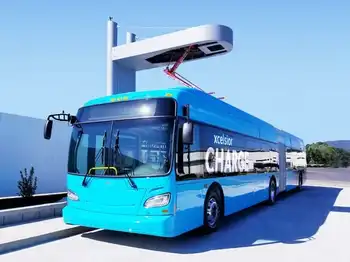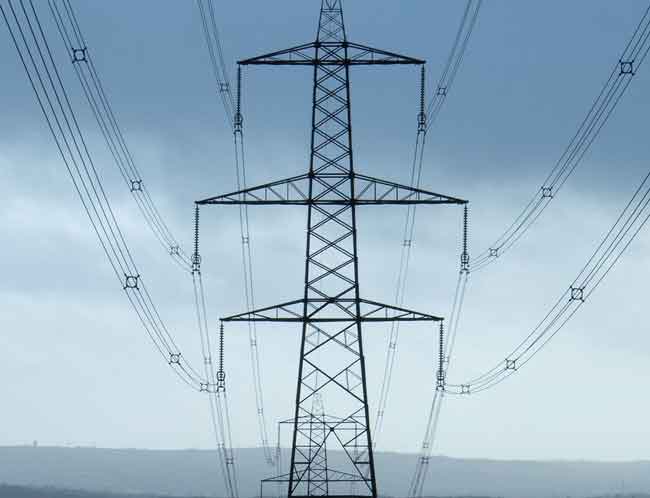Elusive Force May Lie at Root of Blackout
- It is a little-understood component of electricity, so arcane that engineers sometimes call it "imaginary power."
But it was a shortage of this elusive force, largely unknown and unappreciated by the general public but critical to the operation of the nation's electrical grid, that experts now say probably set off the largest blackout in North American history on Aug. 14.
Imaginary power, known to scientists as reactive power, cannot turn on lights or run toasters. Yet power plants and lines need it to create the conditions that allow hundreds of thousands of megawatts to flow across the continent.
Scientists often compare it to poles holding up the vast tent that is the country's power grid.
Experts now think that on Aug. 14, northern Ohio had a severe shortage of reactive power, which ultimately caused the power plant and transmission line failures that set the blackout in motion. Demand for reactive power was unusually high because of a large volume of long-distance transmissions streaming through Ohio to areas, including Canada, that needed to import power to meet local demand. But the supply of reactive power was low because some plants were out of service and, possibly, because other plants were not producing enough of it.
That troubles with reactive power could be behind the failure is not a surprise to many industry officials and other energy experts.
Profound changes in the electricity markets, driven by deregulation, have made such a precarious combination of conditions more likely in recent years, industry officials, academics and power consultants say. The United States and Canadian investigation into the blackout has not been completed. But among experts who have studied the failure, a consensus has emerged that market-driven problems with reactive power existed that day and played into the blackout.
"It is definitely a contributor," said Raymond J. Palmieri, compliance program manager at East Central Area Reliability Coordination Agreement, an industry group charged with ensuring the delivery of power in the Midwest, including Ohio, where the blackout started. Mr. Palmieri said it appeared that a lack of reactive power, measured in what are known as VAR's, led to low voltage on transmission lines and threatened the stability of the system.
Some power industry officials have said they were embarrassed by the events of Aug. 14, when tens of millions of people from Michigan to Connecticut lost power. Potentially more embarrassing is that the threat of reactive power problems was so widely known.
Analysts have blamed instability in reactive power that brought on voltage collapses for a blackout on the Pacific Coast in July 1996 and a 1978 blackout across France. And for years, electricity experts have warned that market changes like the breakup of utility monopolies and greater reliance on long-distance transmission have increased the need for reactive power but curbed the motivation to produce it.
A reactive power deficit alone cannot explain what happened last month, because even when such problems arise, power companies and regional agencies that monitor the grid are supposed to intervene and stabilize the system.
But if the intervention is too slow, voltage on power lines can collapse suddenly, and the lights go out.
Reactive power, like ordinary or "real" power, results from the interplay of electricity's two basic elements: the flow of electrons through the wires and the force pushing them along. These two factors oscillate at slightly different moments, many times per second.
When the flow and the force are aligned, they produce real power, measured in watts, which does the apparent work in the system, running stoves and televisions. When they are not, they produce reactive power, measured in VAR's, or volt-amperes reactive. Power plants, power lines and some kinds of machinery consume reactive power, using it to maintain the magnetic fields that they need to operate.
Traditionally, a local utility was a largely self-sufficient monopoly that generated nearly all the power its system needed, including reactive power. It owned all the power plants in its territory, and most electricity was produced near where it was used.
Deregulation, urged on by Congress a decade ago, transformed that system in ways that were much in evidence on Aug. 14.
One of the most important changes was the proliferation of "merchant plants," power plants located in a particular utility's region but owned by a different company.
In just the past 15 months, three merchant plants began operating in southeastern Ohio. On Aug. 14, several plants in Ohio and Michigan that are operated by the utilities where they are located were down for repairs, and units at two other plants shut down that day for reasons that remain unclear.
Power plants can produce both VAR's and watts, and can fine-tune the output of both. When the same company owned all of a region's power plants and transmission wires, and had all the customers, it had no choice but to ensure that there was enough reactive power.
But merchant plants, pumping electricity through someone else's lines, often have little or no incentive to produce VAR's, because they are paid primarily for producing real power.
"The real money is in the watts, not the VAR's," said Karl E. Stahlkopf, senior vice president of the Hawaiian Electric Company, who studied the 1996 blackout.
Hours before the Aug. 14 blackout, operators at FirstEnergy, the utility that serves much of northeastern Ohio, noticed a peculiar thing: voltage across their system was below normal, a sign of insufficient reactive power. Even though FirstEnergy was importing thousands of megawatts from southern Ohio, "we were exporting VAR's outside the FirstEnergy system the whole day," said Charles E. Jones, a senior vice president. "That's not normal."
Mr. Jones said merchant plants in the region were producing large amounts of real power but very little reactive power to support it. The owners of three new merchant plants in southeast Ohio, the Duke Energy Corporation and PSEG Power, say the plants were generating nearly as many megawatts as they could on Aug. 14, but would not say how many VAR's they were producing.
Another change has been a sharp rise in long-distance power transactions. More than ever, a plant outside Cincinnati, for example, might feed Chicago. That trend, and a rising demand for power, has increased the burden on transmission lines.
As a line's load rises, the amount of reactive power it needs rises even faster. The demand for electricity on Aug. 14 was not especially high in the Midwest, but FirstEnergy officials say their transmission lines were carrying one-third more power than they expected.
Each stretch of transmission line consumes a certain amount of reactive power, and the greater the distance, the more VAR's needed.
Long-distance transmission also makes the need for reactive power unpredictable, experts say. Transactions can travel dozens of paths at once, in complex, varying patterns.
It has become much harder for grid operators to know "where you need the VAR's and how many you need," said Dr. Benjamin A. Carreras, a physicist at Oak Ridge National Laboratory in Tennessee.
On Aug. 14, FirstEnergy's operators attempted to correct for a deficit in reactive power and a resulting decline in voltage on their system. By about 1:15 p.m., they say, voltage had dropped 3 to 4 percent, close to the 5 percent threshold considered a serious problem.
FirstEnergy then adjusted nine power plants to produce more reactive power, but that led to trouble at one plant, Eastlake, northeast of Cleveland. Operators there, after several adjustments to control voltage, saw the generator shut itself off.
Suddenly, northeast Ohio had an even larger reactive power deficit, and more strain on its transmission lines. At 2:02 p.m., a brush fire caused a major line in southwest Ohio to fail, redirecting power loads onto other lines, and once again increasing the need for reactive power. Then, starting at 3:05 p.m., a series of lines linking the Cleveland area to its power supplies to the south failed.
At 4:09 p.m., the last links between northern and southern Ohio shut down. The system began to falter, and within two minutes, the blackout had struck.
A failure so widespread has focused attention on concerns about reactive power that have long brewed beneath public awareness. Yet even critics of the current system say that its weakness does not mean there should not be long-distance transactions — and that, in any case, it would be impossible to return to the old, more localized system.
But as Aug. 14 demonstrated, the new configuration of the markets carries new risks, and the stakes are much higher. Experts say the blackout points to the need for closer monitoring of reactive power, greater incentives for producing it, penalties for failing to do so and, maybe, new ways to create it.
"Especially after what happened in the '96 blackout in the West, monitoring reactive power should have been one of the key aspects of operating the power system," said Mani V. Venkatasubramanian, an associate professor of electrical engineering at Washington State University who studied the 1996 collapse in the West. "Now, there's no excuse for not doing it at every utility."
Related News

Physicists Just Achieved Conduction of Electricity at Close to The Speed of Light
LONDON - When it comes to data transfer and computing, the faster we can shift electrons and conduct electricity the better – and scientists have just been able to transport electrons at sub-femtosecond speeds (less than one quadrillionth of a second) in an experimental setup.
The trick is manipulating the electrons with light waves that are specially crafted and produced by an ultrafast laser. It might be a long while before this sort of setup makes it into your laptop, but the fact they pulled it off promises a significant step forward in terms of what we can expect from our…




